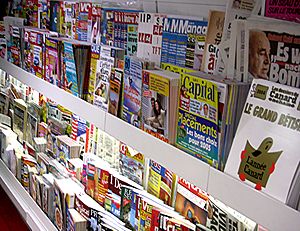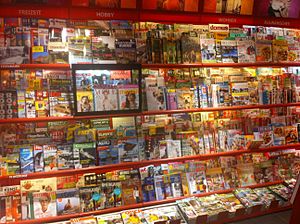Magazine facts for kids
A magazine is a special kind of book that people read. Unlike regular books, new versions of magazines are printed many times each year. They are called periodicals because new issues keep coming out regularly. Magazines are printed on paper. Often, people subscribe to them to get new issues delivered to their homes. An example of a magazine is Time. You can find magazines about almost anything you can imagine! Magazines are a bit like newspapers, but they usually take longer to create, cost more, and are printed in full color on every page. Sometimes, magazines even come with small gifts for their readers!
Contents
How Magazines Reach You
Magazines can get to readers in a few different ways. They might be sent through the mail, sold at newsstands, bookstores, or other shops. Some magazines are even given away for free at special pick-up spots. The main ways magazines are delivered often fall into three groups.
Buying a Magazine
This is when you pay money for a magazine. You can buy a single issue, or you can subscribe for a year. With a subscription, you pay a fee, and new issues are sent to you by post. This way, publishers know exactly how many people are reading their magazine.
Free Magazines
Some magazines are given away for free. They might be found in street dispensers, on airplanes, or included with other products. Since these magazines are given to many different people, publishers only know how many copies were given out, not exactly who reads them.
Special Free Magazines
This method is often used for magazines about specific jobs or industries, called trade magazines. These magazines are usually given for free only to certain readers who qualify. For example, a magazine about computers might only be sent to people who work in the computer industry. Publishers do this to make sure their advertisements reach the right people. It also helps them save money on printing and sending copies to people who might not be interested. This way of distributing magazines was very common before the World Wide Web became popular, and some magazines still use it today. For example, in the United Kingdom, magazines like Computer Weekly and Computing use this model.
Images for kids
-
The Olympic Number of Life, 10 Jul 1924. Issues of general interest magazines focused on a specific subject were referred to as "numbers" and featured cover art relevant to the given topic, in this case the 1924 Summer Olympics.
-
1928 issue of Popular Aviation, which became the largest aviation magazine with a circulation of 100,000.
-
Egyptian movie star Salah Zulfikar on the cover of Al-Kawakeb magazine, March 1961
See also
 In Spanish: Revista para niños
In Spanish: Revista para niños









